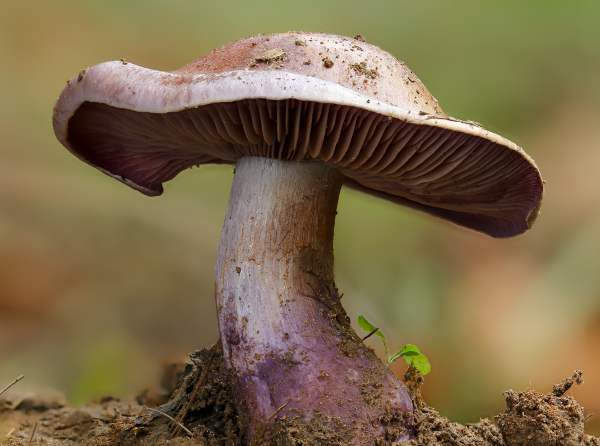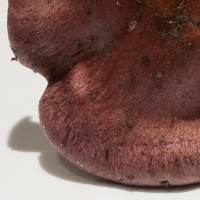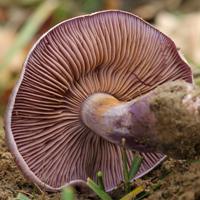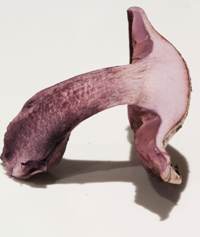Cortinarius purpurascens ( Fr.) Fr. - Bruising Webcap
Phylum: Basidiomycota - Class: Agaricomycetes - Order: Agaricales - Family: Cortinariaceae
Distribution - Taxonomic History - Etymology - Toxicity - Identification - Reference Sources

Cortinarius purpurascens is one several purplish webcaps that are difficult to separate on macroscopic characters. In Britain it fruits in broadleaf woodlands mainly with oak and beech, but in North America this species (or its doppelganger) is recorded from coniferous forests.
Distribution
An uncommon species in Britain and Ireland, the Bruising Webcap is recorded also in many parts of mainland Europe and in North America.
Taxonomic history
When the great Swedish mycologist Elias Magnus Fries described this mushroom in 1818, he gave it the binomial name Agaricus purpurascens. Twenty years later, in his Epicrisis Systematis Mycologici of 1838, Fries transferred this species to the genus Cortinarius, establishing its currently-accepted scientific name Cortinarius purpurascens.
Synonyms of Cortinarius purpurascens include Agaricus purpurascens Fr., Cortinarius purpurascens var. largusoides Cetto, and Phlegmacium purpurascens (Fr.) Ricken.
Etymology
The generic name Cortinarius is a reference to the partial veil or cortina (meaning a curtain) that covers the gills when caps are immature. In the genus Cortinarius most species produce partial veils in the form of a fine web of radial fibres connecting the stem to the rim of the cap rather than a solid membrane.
Just as you might expect, the specific epithet purpurascens indicates that the flesh of this mushroom turns purple, and indeed so it does when its stem or its cap is bruised.
Toxicity
Although it has been recorded as edible, this mushroom is best regarded as 'suspect' because many very similar webcaps contain dangerous toxins - hence it should not be gathered for eating. Some reddish-brown Cortinarius mushrooms with which the Blushing Webcap could perhaps be confused contain the toxin orellanine, which if eaten destroys human kidneys and liver.
Identification guide
 |
CapVarious shades of dirty ochraceous brown with a radially fibrillose margin that is violet when young but gradually turns brown, the cap is viscid when wet; convex, eventually flattening almost completely and developing a wavy margin; 4 to 10cm across. The cap margin gradually loses its fibrils and becomes smooth as the fruitbody ages. |
 |
GillsViolet-brown when young, becoming more buffish and eventually rust-brown, the gills of the Bruising Webcap are adnate or broadly emarginate (with a notch quite near to the stem). On young caps the cortina is pale violet or almost white. Like the rest of this webcap, the gills turn purple if they are bruised. |
 |
StemViolaceous, becoming stained rusty brown as spores fall from the gills, the stem of Cortinarius purpurascens is solid and fairly cylindrical over most of the length but swollen towards the base, 5 to 12cm long and 1.5 to 2.5cm in diameter, with a (sometimes marginate) basal bulb up to 3cm across. The stem flesh is violaceous, turning purple when cut and exposed to air. |
SporesEllipsoidal to amygdaloid (almond-shaped), with a roughened surface, 8.5-10 x 4.5-6μm (rather narrower than most other webcaps). Spore printRusty brown. |
|
Odour/taste |
Taste mild; odour pleasant but not significant. |
Habitat & Ecological role |
In broadleaf and mixed woodland, particularly under oaks and Beech in Britain and Ireland. A mushroom currently given the same name (but perhaps not co-specific) grows under conifers in North America. |
Season |
August to November in Britain and Ireland. |
Similar species |
Cortinarius violaceus is deep purple outside and in. |
Reference Sources
Fascinated by Fungi, 2nd Edition, Pat O'Reilly 2016, reprinted by Coch-y-bonddu Books in 2022.
Funga Nordica, Henning Knudsen and Jan Vesterholt, 2008.
Fungi of Switzerland Agarics, part 3: Cortinariaceae, Breitenbach, J., Kränzlin, F.
BMS List of English Names for Fungi
Dictionary of the Fungi; Paul M. Kirk, Paul F. Cannon, David W. Minter and J. A. Stalpers; CABI, 2008
Taxonomic history and synonym information on these pages is drawn from many sources but in particular from the British Mycological Society's GB Checklist of Fungi.
Acknowledgements
This page includes pictures kindly contributed by David Kelly.
Fascinated by Fungi. Back by popular demand, Pat O'Reilly's best-selling 450-page hardback book is available now. The latest second edition was republished with a sparkling new cover design in September 2022 by Coch-y-Bonddu Books. Full details and copies are available from the publisher's online bookshop...

